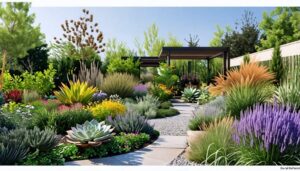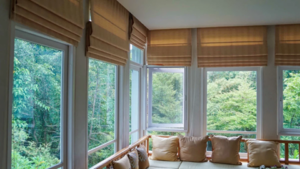How to Invite Texture Into Your Outdoor Living Design

Add texture to outdoor living spaces. It will create visual interest, depth, and character. You can design a cosy patio, a lush garden, or a sprawling backyard oasis. They add dimension and personality to your outdoor environment. In this article, we at New Home Moving will explore various texture techniques and ideas to incorporate into your outdoor design.
Use Layering Materials
Use layering materials to effectively incorporate texture into your outdoor space. Mix and match materials such as wood, stone, metal, and fabric. They will create contrast and visual interest. Combine a natural stone patio with wooden furniture and metal accents. They will establish a harmonious and textured look.
Also, incorporate tactile elements such as plush cushions, woven textiles, and weathered finishes. They will make your outdoor space feel warm and comfortable.
Try layering things vertically as well. For example, add pergolas with hanging vines or cascading curtains. They will create visual interest and depth in your design.
Incorporate Natural Elements
Add driftwood, plants, rocks, and other natural elements. They will give your outdoor living area unique beauty and texture. Use rocks and boulders in your landscape. They will create natural boundaries, retaining walls, or focal points. Use worn branches and driftwood to create a rustic and marine environment.
Mix in a range of plants with different textures, shapes, and foliage colours. They will create a lush, layered landscape that satisfies all the senses.
Also, use natural elements like sand, gravel, or pebbles in your outdoor design. These elements will add texture and remind you of a natural beach or desert landscape.
You can book professional landscaping and garden design services to assist you with all creative projects.
Embrace Textured Surfaces
Include textured surfaces, such as stamped concrete, wall panels, or paving stones. These elements will enhance the visual and tactile appearance of your outdoor space.
Also, use paving stones with natural textures like flagstone, cobblestone, or slate. They will create a cosy and rustic feel on your patio surface.
You can simulate the appearance of natural materials like wood, brick, or tile with stamped concrete. They ensure durability and low maintenance of your landscaping.
Experiment with textured wall panels or cladding materials like stone veneer or concrete. You can create accent walls or main focal points that give your outdoor space depth and personality.
You may also add textures to metal items, such as natural rust or vintage elements. They will give your outdoor space an industrial old-fashioned style.
Add Dimension with Plantings
Give your outdoor living design depth and appeal with different textures, hues, and shapes found in plants. Use a variety of plant heights, foliage hues, and textures. The greenery will add layers and depth to your landscape.
Also, combine strong, geometric succulents and agave plants with delicate, billowy grasses. They will establish an eye-catching and textural planting pattern in your garden.
Another idea is to use plants with intriguing textures, such as fuzzy leaves, rough bark, or smooth foliage. They will provide tactile interest and encourage curiosity in your outdoor area.
Include living walls or vertical gardens in your outdoor design. These beautiful features will optimise planting space and give texture to vertical surfaces
Incorporate Decorative Accents
You can add decorative elements like couch cushions, lanterns, outdoor rugs, and artwork. They will give your outdoor living area additional charm and texture.
Opt for outdoor rugs made of natural fibres such as sisal or jute or with textured weaves and patterns. These features will make your seating area warm and cosy.
Mix decorative pillows with tactile materials like velvet, linen, or canvas. These elements will add visual interest and comfort to your resting area.
Also, we advise you to hang lanterns or outdoor artwork with sophisticated patterns, textures, or accents. They will give your outdoor space a touch of elegance and charm.
You can incorporate decorative elements like mosaic tile accents, handmade sculptures, or ornamental fire pits. Such elements will further add individuality to your outdoor space.
Create Water Features
Water features are great additions to your landscape. They will add movement, sound and texture to the desirable areas. Choose water features with textured surfaces. For example, look for stacked stones, pebbles, or sculptural elements. These garden components create visual interest and tactile appeal.
Additionally, incorporate water plants such as water lilies, lotus, or papyrus. They will soften the edges of your water feature and add a natural and textural element.
Add lighting elements such as underwater LEDs or spotlights to illuminate the water feature at night. These elements will also create a magical ambience and enhance the water feature’s textural qualities. You can incorporate interactive water features as well. They can be splash pads, misters, or water walls. Such features add an element of sensory stimulation to your outdoor space.
Utilise Lighting Effects
Lighting can significantly improve your outdoor living space’s texture and ambience. Use accent lighting, ambient and task to emphasise textural aspects and establish nice atmosphere. Add low-voltage lighting on textured surfaces. For example, use it on decorative plants, textured paving stones, and stone walls. This lighting installation will provide a warm and inviting atmosphere to your outdoor space.
Use overhead lighting on pergolas, arches and columns. This design will create intense shadows on textured architectural features and emphasise fine details.
Also, add lighting fixtures with textured finishes like frosted glass, braided rattan, or hammered metal. These fixtures will complement the textural features in your outdoor setting and to add visual interest.
In conclusion
Texture is a powerful design element. It can transform your outdoor living space into a sensory-rich environment. Use layering materials, incorporate natural elements or add textured surfaces that delight the eyes, hands, and soul.





